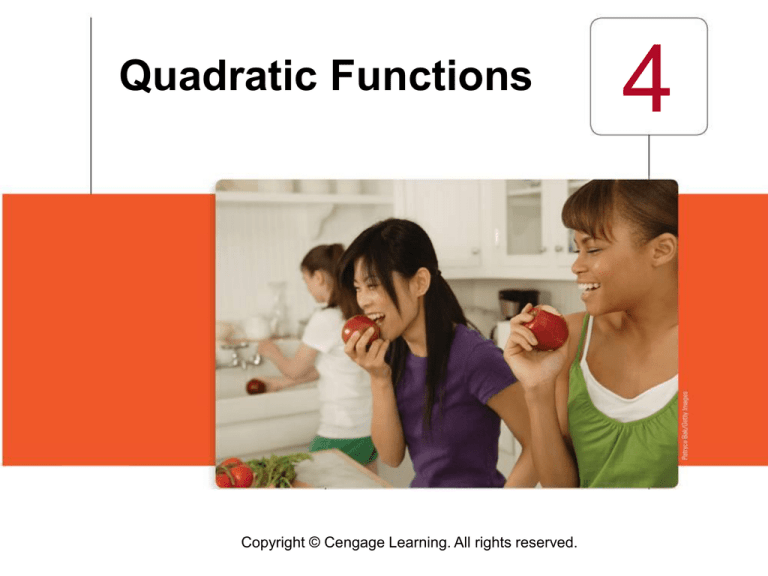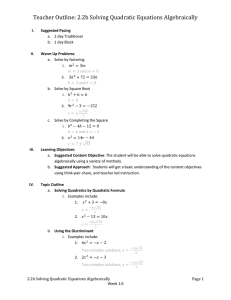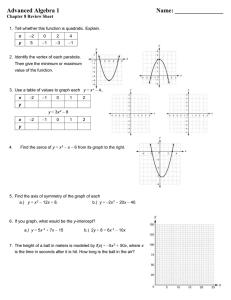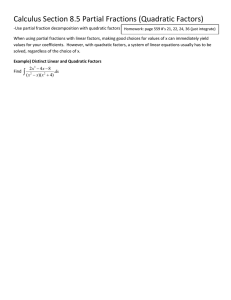
Quadratic Functions
Copyright © Cengage Learning. All rights reserved.
4
4.6
Solving Quadratic Equations by Using
the Quadratic Formula
Copyright © Cengage Learning. All rights reserved.
Objectives
Solve a quadratic equation using the quadratic
formula.
Solve systems of equations with quadratics.
3
Solving by the Quadratic Formula
4
Solving by the Quadratic Formula
If we start with a standard quadratic form, we can solve for
x while leaving the coefficients and constants unknown.
The only requirement is that a 0, or the division would be
undefined and the equation would not be a quadratic.
ax2 + bx + c = 0
ax2 + bx = –c
We start with the standard quadratic equal to zero.
Move the constant to the other side of the
equal sign.
Divide by a to make the leading coefficient 1.
Note: a cannot equal zero, so that division
by a is defined.
5
Solving by the Quadratic Formula
Add a constant that will complete
the square (half of the coefficient
of x, squared).
Factor and simplify.
Use the square root property.
6
Solving by the Quadratic Formula
Simplify the denominator of the radical.
Get x by itself.
7
Solving by the Quadratic Formula
Because we solved the quadratic equation for any values
for a, b, and c, the mathematics will be true for any real
values of a 0, b, and c.
Therefore, in general, we have solved any quadratic from
standard form. The final result is called the quadratic
formula.
This formula can be used to solve any quadratic equation
in standard form as long as the equation equals zero.
8
Solving by the Quadratic Formula
9
Example 1 – Using the quadratic formula
Solve the following quadratic equations. Round your
answers to three decimal places. Check your answers.
a. 3x2 – 6x – 24 = 0
b. 4t2 – 8t + 5 = 50
c. 3.4x2 + 4.2x – 7.8 = 0
Solution:
a.
3x2 – 6x – 24 = 0
The equation is in standard form
and equal to zero, so use the
quadratic formula.
10
Example 1 – Solution
cont’d
Separate into two equations.
Simplify.
11
Example 1 – Solution
x=4
cont’d
x = –2
3(4)2 – 6(4) – 24 ≟ 0
Check both answers.
48 – 24 – 24 ≟ 0
0=0
3(–2)2 – 6(–2) – 24 ≟ 0
12 + 12 – 24 ≟ 0
0=0
Both answers work.
12
Example 1 – Solution
b.
4t2 – 8t + 5 = 50
cont’d
Set the equation equal to zero.
4t2 – 8t – 45 = 0
Use the quadratic formula.
13
Example 1 – Solution
cont’d
Separate into two equations
Simplify
Check both answers using the
table.
Both answers work.
14
Example 1 – Solution
c.
cont’d
3.4x2 + 4.2x – 7.8 = 0
Separate into two equations.
Simplify.
15
Example 1 – Solution
x 1.018
cont’d
x –2.253
Check both answers using the
graph.
Both answers work.
16
Determining Which Algebraic Method to Use
When Solving a Quadratic Equation
17
Determining Which Algebraic Method to Use When Solving a Quadratic Equation
When we are faced with an equation to solve, we should
first decide which type of equation we are trying to solve
(linear, quadratic, or higher-degree polynomial) and then
choose a method that is best suited to solve that equation.
We have looked at four algebraic methods to solve a
quadratic equation:
• Square root property
• Completing the square
18
Determining Which Algebraic Method to Use When Solving a Quadratic Equation
• Factoring
• Quadratic formula
Determining what method is best depends on the
characteristics of the equation we are trying to solve.
19
Determining Which Algebraic Method to Use When Solving a Quadratic Equation
Square Root Property
The square root property works best when the quadratic is
in vertex form or when there is a squared variable term but
no other variable terms.
(x + 5)2 – 9 = 16
x2 + 13 = 49
6x2 – 4 = 18
In all of these equations, the square root property would be
a good method to use.
20
Determining Which Algebraic Method to Use When Solving a Quadratic Equation
Remember, when solving using the square root property, to
isolate the squared variable expression on one side before
using the square root property. Also do not forget to use the
plus/minus symbol to indicate all possible answers.
Completing the square
Completing the square works well for equations that have
both a squared term and a first-degree term. This method is
usually easiest if the numbers are not too large and the
leading coefficient is 1.
21
Determining Which Algebraic Method to Use When Solving a Quadratic Equation
x2 + 4x + 9 = 0
x2 – 5x = 20
After completing the square, we will again use the square
root property to solve.
Factoring
Factoring works best when the numbers are not too large
or when the terms are higher than second degree. Always
remember to first factor out the greatest common factor.
Although factoring does not work with all quadratics, if the
equation factors easily, it can be one of the fastest solution
methods.
22
Determining Which Algebraic Method to Use When Solving a Quadratic Equation
For factoring to be used when solving, the equation must
be equal to zero so that the zero product property can be
used.
x2 + 5x + 6 = 0
x3 + x2 – 6x = 0
Equations that cannot be factored may still have solutions,
so use one of the other methods, such as completing the
square or the quadratic formula.
Occasionally, an equation can be factored partially, and
then the separate pieces can be solved using another
method.
23
Determining Which Algebraic Method to Use When Solving a Quadratic Equation
Quadratic Formula
The quadratic formula will work with any quadratic, but it is
easiest if the quadratic starts out in standard form.
Because the quadratic formula basically requires
substituting values for a, b, and c and then simplifying an
arithmetic expression, the formula will work equally well for
large or small numbers.
Whenever a quadratic equation has decimals or fractions,
the quadratic formula is probably the best method to
choose.
24
Determining Which Algebraic Method to Use When Solving a Quadratic Equation
5x2 + 16x – 85 = 0
0.25x2 – 3.4x + 9 = 0
In solving with the square root property or the quadratic
formula, a negative under the square root will indicate no
real solutions.
25
Example 3 – Choosing a method to solve equations
Solve the following equations using any method you wish.
Check your answers using the calculator table or graph.
a. 5x3 + 37x2 – 5x = –19x
b. x2 + 12x + 7 = 0
c. 5x2 – 30 = 40
d. 2x(x + 5) = 4x
e. x3 + 8x2 + 5x = 0
26
Example 3(a) – Solution
cont’d
This equation has a third-degree term, so we will try to
factor it and break it up into smaller pieces that will be
easier to solve.
The first step will be to set one side of the equation equal to
zero.
5x3 + 37x2 – 5x = –19x
5x3
+
37x2
+ 14x = 0
x(5x2 + 37x + 14) = 0
Set the equation
equal to zero.
Factor.
x(5x2 + 2x + 35x + 14) = 0
27
Example 3(a) – Solution
cont’d
x[(5x2 + 2x) + (35x + 14)] = 0
x[x(5x + 2) + 7(5x + 2)] = 0
x(x + 7)(5x + 2) = 0
x=0
x=0
x+7=0
x = –7
5x + 2 = 0
Separate into three
equations and solve.
x=
Check all the three
answers using the table
All the answers work.
28
Example 3(b) – Solution
cont’d
This equation does not factor (try it!), so we must use
another method. Since the equation has a squared term
and a first-degree term, we will not be able to use the
square root property directly.
Therefore, we could complete the square and then use the
square root property.
x2 + 12x + 7 = 0
Complete the square.
x2 + 12x = –7
x2 + 12x + 36 = –7 + 36
(x + 6)2 = 29
29
Example 3(b) – Solution
cont’d
Use the square
root property.
Separate into two
equations and solve.
Check all the three
answers using the
graph
Both answers work.
30
Example 3(c) – Solution
cont’d
This equation has no first-degree term, so the square root
property will be a good method to choose. First isolate the
squared variable expression.
5x2 – 30 = 40
Isolate the squared variable expression.
5x2 = 70
x2 = 14
Use the square root property.
Separate into two equations and solve.
31
Example 3(c) – Solution
cont’d
Check both the answers
using the table
Both answers work.
32
Example 3(d) – Solution
cont’d
This equation looks like it is already factored. Since it does
not equal zero, we will have to multiply it out and set it
equal to zero before we can factor and solve.
2x(x + 5) = 4x
Multiply out using the
distributive property.
2x2 + 10x = 4x
2x2 + 6x = 0
2x(x + 3) = 0
2x = 0
x=0
x+3=0
Set the equation
equal to zero.
Factor.
Separate into two
equations and solve.
x = –3
33
Example 3(d) – Solution
cont’d
Check both the answers
using the table
Both answers work.
34
Example 3(e) – Solution
cont’d
This equation has a third-degree term, so it should be
factored.
x3 + 8x2 + 5x = 0
Factor out the common
term.
x(x2 + 8x + 5) = 0
The equation cannot be factored any further.
We will set each factor equal to zero and then solve the
remaining quadratic equation using the quadratic
formula.
35
Example 3(e) – Solution
x=0
or
x2 + 8x + 5 = 0
cont’d
Separate into two
equations and solve.
a=1 b=8 c=5
Use the Quadratic Formula.
Simplify the radical.
36
Example 3(e) – Solution
cont’d
This equation appears to have three answers. Check them
in the table.
All the answers work.
37
Solving Systems of Equations with
Quadratics
38
Solving Systems of Equations with Quadratics
Let us consider systems of equations that contain
quadratics.
We have learned that we could solve systems using three
different methods: graphing, substitution, and elimination.
Using graphs and tables to estimate solutions to systems of
equations that involve functions other than lines is the
same process as with linear systems.
When using the graph, we look for the place(s) where the
two graphs intersect.
39
Solving Systems of Equations with Quadratics
When using a table, we find input value(s) that make the
outputs for both equations equal.
When looking for these input value(s), notice when one
equation changes from being smaller than the other
equation to being larger than the other.
The intersection of the two equations must be between
these input values.
40
Example 4 – Using graphs and tables to solve systems of equations
Use the given graph or table to estimate the solutions to
the systems of equations.
41
Example 4 – Solution
a. From the graph, we can see that the two graphs
intersect at about the points (4, 2) and (–2, 14).
b. The table shows that the two equations are equal at the
points (2, 10) and (5, 64).
c. This table does not show any exact places where the
equations are equal. The equation in Y1 is greater than
Y2 at x = –4.4, but Y1 is less than Y2 at x = –4.375. So
there must be an intersection between these values.
One estimate for this intersection could be (–4.38, 0.3).
42
Example 4 – Solution
cont’d
The two equations must also intersect between
x = –0.12 and x = –0.11, so we might estimate this
intersection at about (–0.115, 2.48). Remember that
these are only estimates. Many other answers could be
reasonable.
43
Solving Systems of Equations with Quadratics
Although graphs and tables can be used to find solutions to
these systems, we can also use algebraic methods to
solve. In solving systems that contain quadratics
algebraically, substitution is often the best choice.
44
Example 5 – Solving systems of equations algebraically
Solve the following systems of equations.
a. y = 4x + 9
b. y = 5x2 + 2x + 7
y = x2 + 5x + 3
y = 2x2 – 3x + 10
Solution:
a. y = 4x + 9
y = x2 + 5x + 3
Substitute 4x + 9 for y in the second equation and solve
for x.
4x + 9 = x2 + 5x + 3
Substitute for y.
45
Example 5 – Solution
0 = x2 + x – 6
Set the equation equal to zero.
0 = (x + 3)(x – 2)
Factor.
x+3=0
x–2=0
x = –3
cont’d
Separate into two equations and solve.
x=2
y = 4(–3) + 9
Use the values of x to find the
corresponding values of y.
y = –3
y = 4(2) + 9
y = 17
(–3, –3)
(2, 17)
These two points are the solutions to
the system of equations.
46
Example 5 – Solution
cont’d
These answers can be checked by using either the table
feature or the graph feature on the calculator. First, put
both equations into the Y = screen, and then graph them
using a window that will include both answers.
Another option is to go to the table and input both x-values
to see whether the y-values are the same. Remember that
some rounding error can occur if the solutions were not
exact.
47
Example 5 – Solution
cont’d
b. y = 5x2 + 2x + 7
y = 2x2 – 3x + 10
Substitute for y and solve for x.
5x2 + 2x + 7 = 2x2 – 3x + 10
3x2 + 5x –3 = 0
a = 3 b = 5 c = –3
Substitute for y and simplify.
You are left with a quadratic
equation that can be solved by
using the quadratic formula.
48
Example 5 – Solution
Use the x-values to find the corresponding y-values.
y = 5(0.468)2 + 2(0.468) + 7
cont’d
49
Example 5 – Solution
cont’d
y = 9.031
y = 5(–2.135)2 + 2(–2.135) + 7
y = 25.521
(0.468, 9.031) (–2.135, 25.521)
There are two answers
to this system
Check the answers using the table or graph.
Both answers work.
50
Solving Systems of Equations with Quadratics
In using the quadratic formula, the value of the
discriminant, b2 – 4ac, determines whether the equation
will have real solutions or not.
When the discriminant is negative, the quadratic equation
will have no real solutions. In the real number system, we
cannot take the square root of negative numbers.
51








